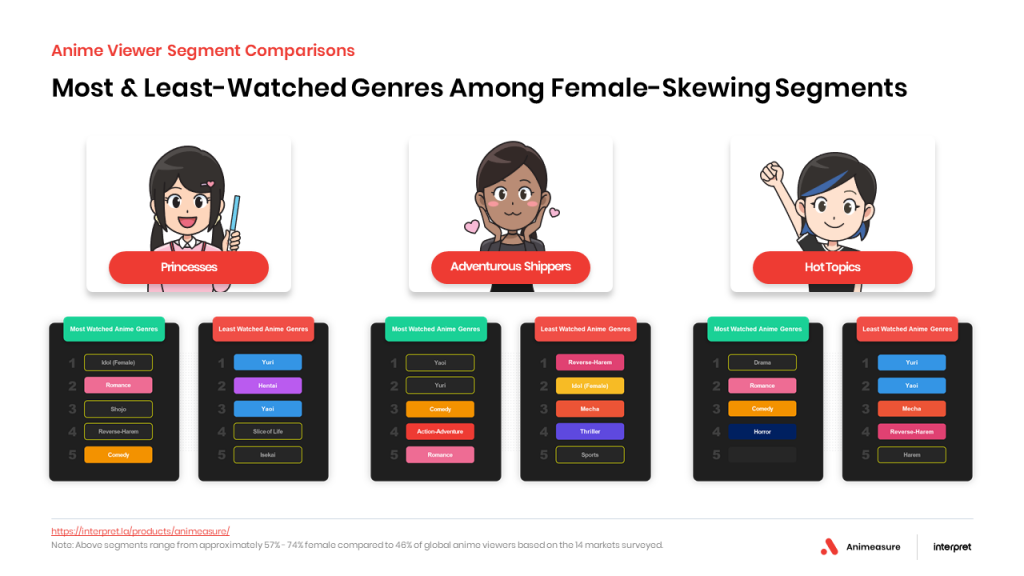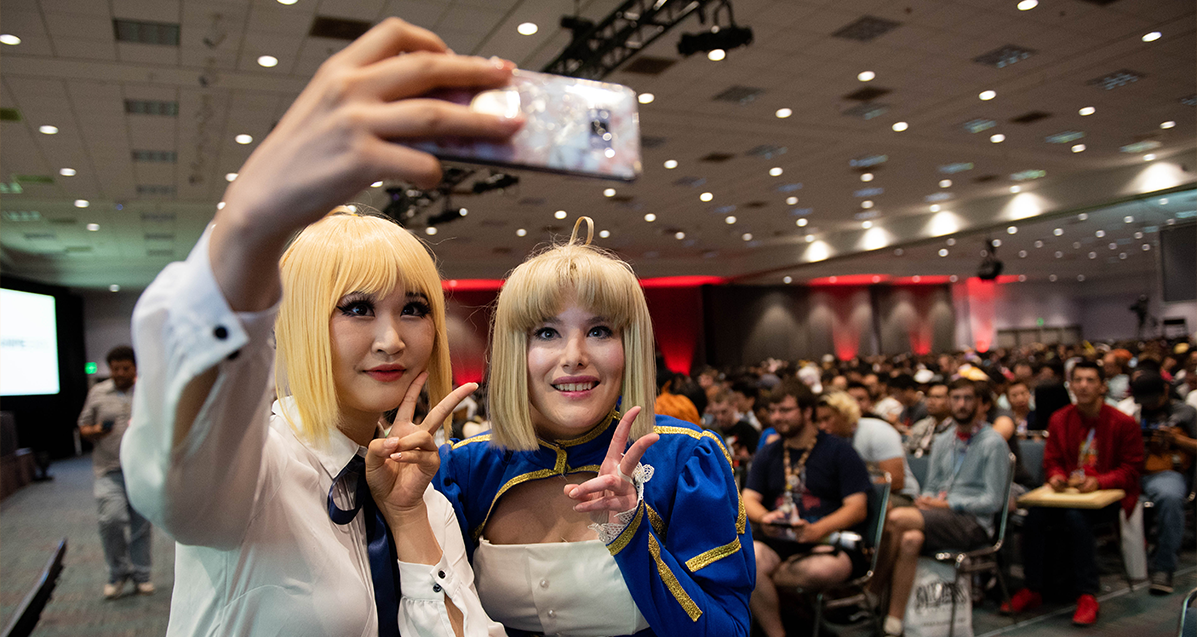Last month, we focused on the presence of female Anime viewers and identified opportunities to better serve this demographic. Following the strong interest shown in this data, this month’s blog will delve deeper into the needs and motivations of these fans.
Interpret has recently completed a segmentation of the anime market, organizing viewers into eight segments to reveal fundamental needs, attitudes, and behaviors common to the clusters within a diverse array of anime viewers. Of these eight, three possess a strong female-identifying skew, and we have coined shorthand terms for each: Princesses, Adventurous Shippers, and Hot Topics.

These three segments do not account for all female anime viewers, nor do they fully exclude male-identifying viewers. However, in comparing the viewing habits of these three segments, we realize the extraordinary diversity among female anime viewers who may, on the surface, hold much in common.
For example, all three female-dominated segments report a strong preference for Romance genre anime. When contextualized by their other reported genre preferences, it becomes apparent that the specific driver of this preference may differ dramatically by the segment.
The tongue-in-cheek ‘Princess’ segment is named for the viewer who sees herself as central to the narrative, embodied by a character or serenaded by the onscreen cast. This segment notably raves over Reverse-Harem series, as well as Female-oriented Idol anime featuring charismatic and attractive male leads.
By contrast, Princesses report a strong aversion to the most preferred genres of Adventurous Shippers: Yaoi (Boys’ Love) and Yuri (Girls’ Love). Though both groups overwhelmingly identify as female, we interpret this divergence as being rooted in more than a rejection or acceptance of homoromantic narratives. The Adventurous Shipper preference may be informed in part by a desire for narratives that highlight the relationships of others, without requiring the viewer to identify themselves as the subject of the characters’ affections.
Hot Topics bring a bit of edge to our warm and fuzzy dialogue, citing Romance alongside Drama, Comedy, and Horror as their favorite anime offerings. Unintuitive at first glance, we understand this segment of fans as drawn to powerful anime that elicit strong, cathartic feelings in the storied tradition of body genres (a theory from the world of cinema studies, courtesy of Linda Williams.)
As this analysis shows, the anime genres that segments eschew reveal as much as the genres that they prioritize. The Princess and and Hot Topic segments do not care for Yaoi and Yuri anime. Likewise, Reverse-Harem anime inspire similar disdain among Adventurous Shippers and Hot Topics, implying that neither of these segments neatly align with the Princess ideal. Horror is horrifying to the majority of Princess segment viewers, and elicits a lukewarm response from Adventurous Shippers, but Hot Topic segment viewers keep the heartthrobs, sobs, and screams coming in their entertainment queue, carving out a clear third space for female fandom.
Put another way, all three segments might have tuned in for the climactic final season of Fruits Basket— but while Princesses are cheering on Tohru and Kyo, Adventurous Shippers are tuning in for the non-canon pairings you might not have anticipated, and Hot Topic viewers are vibing with the narrative that combines romance, drama, comedy, and even (spoiler alert!) horror elements.
Perhaps you know someone who resembles one of these data-based profiles. What else might we learn from the viewing habits of a given segment? Which, if any, of these segments do you think best aligns with your anime viewing preferences? How do you conceptualize different segments in the anime audience?
To learn more about Interpret’s anime consumer insights offerings like Animeasure, you can visit our website at: https://interpret.la/products/animeasure/
An Adventurous Shipper and a Princess Walk into a Hot Topic: The Art of Segmentation
John McCallum examines the most and least-watched genres among female-skewing segments.
5 Survey-Creation Tips from Anime Academics
With all the advantages surveys offer, it makes sense that con organizers would want to use them too. After all, there's no better way to reach thousands of con-goers quickly, effectively, and at a low cost! There's an art to surveys, though: we've all seen versions that we wouldn't take unless we were being paid to, right? In fact, as the researchers behind the Survey of Anime Convention Attendance in Response to Covid-19, we went through our survey exhaustively to try
Female Fandom & Anime: Uninterested or Underserved?
Internationally, Anime Viewers skew slightly male, but this skew is far more pronounced in English-speaking markets like the US, the UK, and Australia. Brazil also sees an above-average share of male viewers. Of all 14 markets surveyed, the US has the smallest fraction of its Anime viewership that identifies as female. Some markets like Vietnam, Russia, and France even see female majorities. In several more, like Korea, China and India, there are nearly even splits. This gender breakdown would likely surprise those
US Genre Preference: How Anime Meets Needs Not Met by Other Media
A lot of the most popular anime series seem like they can be classified as either Action-Adventure or Sci-Fi shows. Sure enough, Action-Adventure and Sci-Fi are the most-watched genres in the United States, and many other of the 14 markets Interpret surveyed. The broadness of that preference will invariably influence production as the industry seeks to court as many viewers of these popular genres as possible. But there is a great deal that the other most-watched genres in the United










